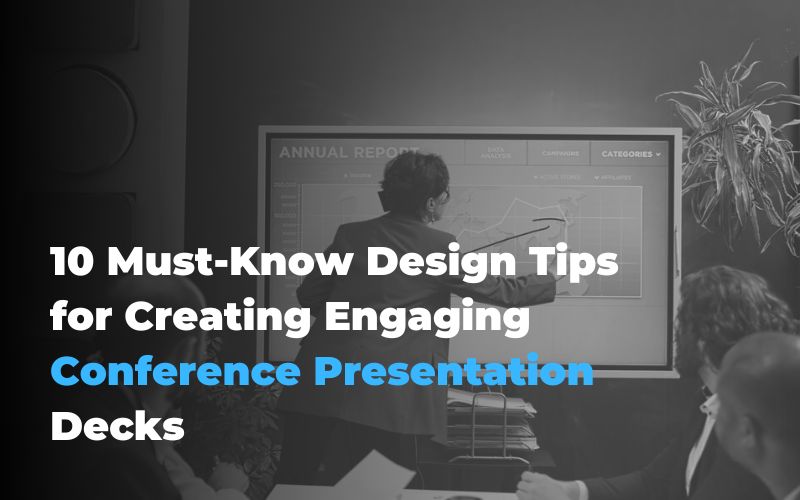[](https://postimg.cc/BPp0jHMQ)
Conference presentation decks are essential tools for delivering impactful messages in professional settings. Whether you're preparing for a keynote speech, a panel discussion, or a specialized conference session, a well-designed presentation deck can make or break your audience's engagement. This blog will outline ten crucial tips to elevate your [**conference presentation designs**](https://www.inkppt.com/guides/mastering-event-presentation/foundations-of-event-production-and-presentation/introduction-to-world-of-event-production-and-services/), ensuring they captivate, inform, and inspire.
## 1. Understand Your Audience
Before diving into design, it's crucial to understand who your audience is. Are they industry professionals, academics, or general attendees? Knowing this helps tailor your content and visuals to meet their expectations and preferences. For instance:
* **For industry professionals**: Use data-driven visuals and charts.
* **For a general audience**: Keep language simple and visuals engaging.
By understanding your audience, your presentation will feel relevant and relatable, ensuring sustained attention.
## 2. Set a Clear Objective
Every presentation deck should have a defined purpose. Are you aiming to inform, persuade, or entertain? Your objective will dictate the structure and design of your slides. For instance:
* Keynote speech decks often focus on storytelling and inspiration.
* Panel discussion slide presentations typically serve as supporting visuals, summarizing key points for panelists and audiences.
Keep your objective in mind to ensure a coherent flow and focused content.
## 3. Adopt a Consistent Design Theme
A unified design theme enhances the professionalism and visual appeal of your presentation. Here’s how you can achieve consistency:
* Choose a color palette aligned with your brand or the conference theme.
* Use the same fonts and font sizes throughout.
* Leverage templates from professional agencies like INK PPT Design Agency, known for creating stunning and cohesive slide designs.
Consistency prevents your deck from looking disjointed and keeps the focus on your content.
## 4. Focus on Minimalism
Cluttered slides can overwhelm your audience. Embrace minimalism by:
* Limiting text to key points (use bullet points sparingly).
* Using ample white space for a clean look.
* Including one main idea per slide.
Minimalistic designs not only enhance readability but also help your audience retain key messages more effectively.
## 5. Incorporate High-Quality Visuals
Visual elements are the backbone of engaging conference presentation designs. Include:
* **Images**: Use high-resolution, relevant images that complement your content.
* **Icons**: Simplify complex ideas with universally recognized icons.
* **Charts and graphs**: Present data in visually appealing formats to make it digestible.
Tools like Canva or Adobe Spark can help create professional visuals, while agencies like INK PPT Design Agency can offer bespoke designs for your needs.
## 6. Leverage Typography Effectively
Typography plays a significant role in the overall appeal of your slides. Follow these guidelines:
* Use no more than two fonts—one for headings and another for body text.
* Ensure font sizes are legible, even from the back of the room (e.g., 28pt for body text and 36pt+ for headings).
* Opt for sans-serif fonts like Arial or Helvetica for a modern, clean look.
Typography should enhance readability and not distract from your message.
## 7. Master the Art of Storytelling
Humans are wired for stories, and incorporating storytelling into your deck can significantly boost engagement. Here’s how:
* Start with a compelling introduction to grab attention.
* Structure your slides to build a narrative arc—problem, solution, and impact.
* Conclude with a powerful takeaway or call to action.
This approach is especially effective for keynote speech decks, where storytelling is paramount.
## 8. Use Animation and Transitions Sparingly
While animations and transitions can add dynamism to your presentation, overusing them can be distracting. Use these elements purposefully:
* Apply subtle animations to emphasize key points.
* Avoid overly flashy transitions that can detract from the content.
* Stick to a consistent transition style throughout your deck.
Well-balanced animations can enhance the flow without overwhelming your audience.
## 9. Prepare for Panel Discussions
When designing panel discussion slide presentations, the focus should be on complementing the dialogue, not overshadowing it. Keep these tips in mind:
* Use slides as prompts rather than detailed scripts.
* Include summary points, not paragraphs.
* Design visually appealing slides that align with the panel’s theme.
These strategies ensure that your slides support rather than compete with the discussion.
## 10. Test and Rehearse
Finally, a beautifully designed deck is only effective if delivered seamlessly. Rehearse your presentation to:
* Check for consistency and flow.
* Identify and correct any design errors or typos.
* Ensure animations and transitions work as intended.
If possible, test your presentation on the actual equipment you’ll use during the conference to avoid technical glitches.
### Conclusion
Creating engaging conference [**presentation designs**](https://www.inkppt.com/solutions) requires a combination of strategy, creativity, and attention to detail. By following these ten tips—from understanding your audience to mastering storytelling and typography—you can craft decks that not only captivate but also leave a lasting impression.
Whether you’re preparing keynote speech decks, panel discussion slide presentations, or general conference slides, agencies like INK PPT Design Agency can provide expert design support to ensure your presentations shine. Elevate your next conference experience with thoughtfully designed slides that resonate with your audience.